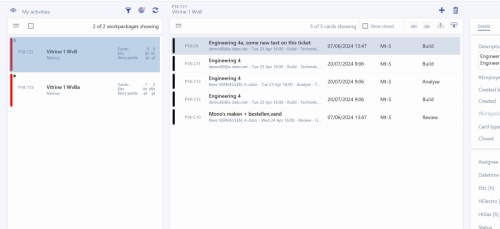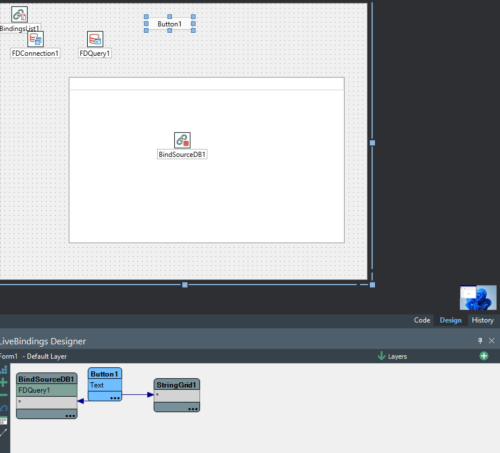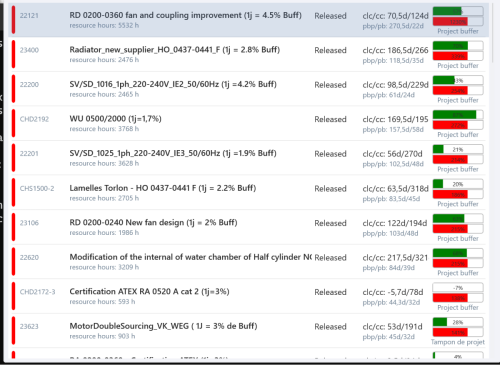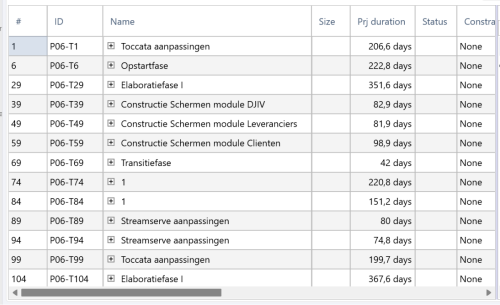

Keesver
-
Content Count
89 -
Joined
-
Last visited
-
Days Won
2
Posts posted by Keesver
-
-
As a last resort you can define your own TDataset type with a public 'FDatasource' member and then cast the TDataset to this type. Design wise this is a clear 'hack' but it will do the job:
unit Unit1; interface uses Winapi.Windows, Winapi.Messages, System.SysUtils, System.Variants, System.Classes, Vcl.Graphics, Vcl.Controls, Vcl.Forms, Vcl.Dialogs, Data.DB, Datasnap.DBClient, Vcl.StdCtrls, System.Generics.Collections; type TForm1 = class(TForm) ClientDataSet1: TClientDataSet; Button1: TButton; DataSource1: TDataSource; DataSource2: TDataSource; procedure Button1Click(Sender: TObject); private { Private declarations } public { Public declarations } end; THackedDataSet = class(TComponent) public FFields: TFields; FAggFields: TFields; FFieldDefs: TFieldDefs; FFieldDefList: TFieldDefList; FFieldList: TFieldList; FDataSources: TList<TDataSource>; end; PHackedDataSet = ^THackedDataSet; var Form1: TForm1; implementation {$R *.dfm} procedure TForm1.Button1Click(Sender: TObject); begin var ds := PHackedDataSet(@ClientDataSet1)^; ShowMessage(ds.Name); for var src in ds.FDataSources do ShowMessage(src.Name); end; end.
-
For the diagrams: take a look at Graphviz. This is an open source project with a lot of traction. It works like an engine, you pass your data to the 'engine' and get a description of the diagram in return. The 'description' can be an SVG document that you can display using a browser or it can be a json document that you parse in your code and paint onto a canvas. The engine can be a dll, executable or external service. Graphiz can handle a many different diagrams.
-
Please check out a-dato/FMX-GRID:
This library includes visual grid control, data models, binding system. Data models are extendible at runtime so that users can add/remove properties from objects.
I can share a link to our demo application so that you can test it yourself.
-
 1
1
-
-
We are also a satisfied user of Thinfinity. We have a 40 user license and run 2 VM's behind a gateway (also part of Thinfinity). Works pretty good. Support is good. Pricing is ok, especially since users are counted as 'concurrent' users (as opposed to named users).
-
 1
1
-
-
Hello,
I learned something new as I didn't know such types do not have RTTI. Any property of such type is hidden when you try to get the properties from a object. This makes it impossible to do automatic marshaling.
Delphi does support custom marshalling using TJSONMarshal (Serializing User Objects - RAD Studio (embarcadero.com)) that allows registration of marshaling functions: procedure RegisterConverter(clazz: TClass; const func: TTypeObjectConverter);
Another option would be to add attributes to your classes to identify these properties and then write your own marshaller that looks at these attributes:
Something like this should work:
TEnum1 = (Value1=20, Value2=40); TEnum1Helper = record helper for TEnum1 function ToString() : string; end; [TJsonEnumproperty('En', UnmarshalFunc, MarshalFunc)] TObjectWithhEnum = class private _id: Integer; _en: TEnum1; published property ID: Integer read _id write _id; property En: TEnum1 read _en write _en; end;Your marshal method then looks at the attributes defined for the class and then call the MarshalFunc/UnmarshalFunc.
Alternatively you can use interfaces to achieve the same.
ICustomMarshalling = interface ['{E799D069-66B8-464D-B718-78D5D4DB6747}'] procedure Marshal(M: TJsonMarshal); procedure UnMarshal(M: TJsonUnMarshal); end; TObjectWithhEnum = class(TObject, ICustomMarshalling) private _id: Integer; _en: TEnum1; proteced procedure Marshal(M: TJsonMarshal); procedure UnMarshal(M: TJsonUnMarshal); published property ID: Integer read _id write _id; property En: TEnum1 read _en write _en; end;In this scenario your custom marshaller checks if your class implements the ICustomMarshalling interface and calls the appropriate methods.
Like to see what solution you come up with...
-
You can encode the image using Base64 encoding. ChatGPT came up with this sample code. Calling TNetEncoding.Base64.EncodeBytesToString(Bytes) will do the actual conversion:
uses System.JSON, System.SysUtils, System.Classes, System.NetEncoding; function ImageToBase64(const FilePath: string): string; var FileStream: TFileStream; Bytes: TBytes; begin FileStream := TFileStream.Create(FilePath, fmOpenRead); try SetLength(Bytes, FileStream.Size); FileStream.ReadBuffer(Pointer(Bytes)^, FileStream.Size); Result := TNetEncoding.Base64.EncodeBytesToString(Bytes); finally FileStream.Free; end; end; procedure SaveImageBase64ToJson; var JSONObject: TJSONObject; Base64String: string; JSONString: string; JSONFile: TStringList; begin Base64String := ImageToBase64('path/to/image.jpg'); JSONObject := TJSONObject.Create; try JSONObject.AddPair('name', 'Example Image'); JSONObject.AddPair('image_data', 'data:image/jpeg;base64,' + Base64String); JSONString := JSONObject.ToString; JSONFile := TStringList.Create; try JSONFile.Text := JSONString; JSONFile.SaveToFile('image_base64.json'); finally JSONFile.Free; end; finally JSONObject.Free; end; end;-
 1
1
-
-
-
This problem has more side effects than expected, after moving a form to a screen with different DPI, the whole form will be re-styled every time a drop down is opened. We filled a report for it:
https://embt.atlassian.net/servicedesk/customer/portal/1/RSS-824?sda_source=notification-emailWorkaround, copy file FMX.Platform.Win to your project then update this method:
function TWinWindowHandle.GetScale: Single; begin if not SameValue(FForcedScale, 0, TEpsilon.Scale) then Result := FForcedScale else if not SameValue(FCurrentScale, 0, TEpsilon.Scale) then Result := FCurrentScale // Add these lines, this will force the scale of the popup control to be the same as the scale of the parent else if (Form <> nil) and (Form.FormStyle = TFormStyle.Popup) and (Form.ParentForm <> nil) then Result := Form.ParentForm.Handle.Scale else Result := GetWndScale(FWnd); FCurrentScale := Result; end; -
Using TNetHttpClient should do the trick and provide HTTPS support without any dll's.
-
Fixed it by adding dw-kastri-base-3.0.0.jar to the project.
-
I'm not using the demo app, I started a new project. I missed this step however, thanks for your info.
-
 1
1
-
-
Hello,
I'm using class TLocalReceiver from a Kastri sample application. When I create a new instance from this class I run into an exception:
Project BroadCast.apk raised exception class EJNIFatal with message 'Java type com/delphiworlds/kastri/DWMultiBroadcastReceiverDelegate could not be found'.In the source code I find this:
[JavaSignature('com/delphiworlds/kastri/DWMultiBroadcastReceiverDelegate')] JDWMultiBroadcastReceiverDelegate = interface(IJavaInstance) ['{1AD78992-D81F-48A4-B341-F82B43094B67}'] procedure onReceive(context: JContext; intent: JIntent); cdecl; end;which tells me the type should have been be registered (I have this file included in the uses of my test application).
What am I missing here, do I have to add code to my application to register this class?
-
Hello,
I'm trying to get the Foreground service demo application to work in Delphi 12. Therefore I copied the files to a new project, checked the manifest files and I got everything set as it should. However when I start the service, an exception is raised inside the service create method:
constructor TServiceModule.Create(AOwner: TComponent); begin inherited; TOSLog.d('TServiceModule.Create - 1'); FLocalReceiver := TLocalReceiver.Create(Self); <-- java.lang.IllegalArgumentException: Receiver not registered: null TOSLog.d('TServiceModule.Create - 2'); FService := TJService.Wrap(System.JavaContext); TOSLog.d('TServiceModule.Create - 3'); CreateNotificationChannel; TOSLog.d('TServiceModule.Create - 4'); end;I think I'm missing something, what should be done to 'Register' a receiver?
Thanks
-
## Free version
A free version is available which is actually quite capable. The free version is named FMX-GRID. This version can be used by any number of developers and offers royalty free distribution of applications.
The free version is published under the MIT license
## Commercial version
FMX-GRID-MODEL is a commercial product. It adds model support and property binding for easy creation of user interfaces. A license is required per developer. Licenses are valid for 12 months, a subscription is required to keep licenses valid. Subscriptons must be renewed after the end date. If you are renewing your license before (or up to 30 days after) the current expiration date, the new expiration date will be calculated based on the original order date. Updates are only available to users with a valid license.
-
We are in a similar situation and support a desktop, mobile, web and MacOs application from a single code base. We use a grid control written by our company which is also publicly available at Git-hub (GitHub - a-dato/FMX-GRID). This is more than just a grid control, as it supports light weight data binding and custom collections, sorting and more. You are welcome to check it out.
-
What is the current state of this project? I'm looking for something like this.
Looks like it made it into Kastri. Will check there first....
-
Delphi 12 Version 29.0.50491.5718:
I just did a small test on a fast MSSql server with a similar query on a very large table and I do not see such a delay. The data is shown quickly. I'm just using FDConnection and FDQuery. Probably your setup is different or your table contains some (big) blob's that are fetched?Also tried ADOConnection/ADOQuery, this was actually a little bit faster.
Please provide a sample.
-
Just to be clear, the application is the same in D11 and in D12? Or are you comparing VCL to FMX?
-
You can add all objects to the same TLayout and then control the opacity from this TLayout.
-
-
Hello all,
We are pleased to anounce the availability of a new Delphi grid control specifically designed for FMX. This control runs on all platforms, is easy on the memory, updatess fast and has smooth scrolling. There is a free version available that includes the following features:
- Connects to different data sources (Lists, List<T>, TDataset)
- Smart row caching results in low memory usage
- Fast scrolling
- Hierarchical views
- Extendable property model based on .Net type system (object properties can be modified at runtime)
- Development backed up by a professional team of FMX developers
- Components used in professional software (Lynx/Lynx-x) by a large user community
We also provide a commercial version, this version adds model support and property binding to visual controls. You can easily bind properties to editors for advanced two way syncing.
Please go to https://github.com/a-dato/FMX-GRID.git to download the free version.
Community site: https://community.a-dato.com
-
 5
5
-
 2
2
-
I can't login into https://quality.embarcadero.com/login.jsp. Is it my account or something else?
Thanks for your feedback
-
ApplyStyleLookup should be called only once when a control is about to be painted. However, when a TDateEdit control is put on a form and the application is moved to a second monitor with a different DPI, ApplyStyleLookup is called every time the drop down of the date editor is opened. The same happens with a TComboBox control. See test application.
We will create a bug report for this at Embarcadero, but maybe someone knows a fix or workaround?
Thanks
-
procedure TFMXPrintForm.btnMakePDFClick(Sender: TObject); var r: TRect; LCanvas: ISkCanvas; LDocument: ISkDocument; LDocumentStream: TStream; LSVGDOM: ISkSVGDOM; LSize: TSizeF; begin LSVGDOM := TSkSVGDOM.MakeFromFile('Delphi.svg'); LSize := TSizeF.Create(300, 300); r.Left := 0; r.Top := 0; r.Width := Round(treeControl.Width); r.Height := Round(treeControl.Height); LSVGDOM.SetContainerSize(LSize); LDocumentStream := TFileStream.Create('Delphi.pdf', fmCreate); try LDocument := TSkDocument.MakePDF(LDocumentStream); try LCanvas := LDocument.BeginPage(r.Width, r.Height); try LSVGDOM.Render(LCanvas); finally LDocument.EndPage; end; finally LDocument.Close; end; finally LDocumentStream.Free; end; end;Also see: Using Skia's PDF Backend | Skia
![Delphi-PRAXiS [en]](https://en.delphipraxis.net/uploads/monthly_2018_12/logo.png.be76d93fcd709295cb24de51900e5888.png)




How can you list all the datasources linked to a dataset?
in VCL
Posted
Thanks, learned something new!